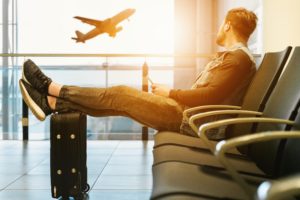Don’t let your travels ruin your slumbers!

A trip away from home often means poor sleep. We’ve all been there. After having done quite a bit of traveling myself, I can attest to that fact. Traveling for conferences, visiting family, friends, moving, and even vacationing can all interfere with sleeping well, especially on the first night at a new place. Sleep researchers refer to this phenomenon as the “first night effect.” In most sleep studies, the first night of sleep is discarded because it is unrepresentative of an individual’s normal sleep pattern. There’s some evidence to suggest that the brain functions differently when we sleep at a new place. Specifically, one hemisphere of the brain is more active, and this has been interpreted as a vigilance state for ensuring the safety of an unfamiliar area. So how do we counteract this phenomenon and sleep well when we’re traveling, even on the first night at a new place? I outline three tips below that focus on a core concept of high quality sleep: consistency.
Create a sleep travel pack.
Maintaining consistency in your sleep environment may involve of a set of physical items that you take with you when you travel. Just as you might pack a set of toiletries, consider creating a “sleep travel pack.” For example, some sleep researchers suggest bringing along your own pillow when sleeping at a new place. One study has shown that the comfort of the hotel environment is linked with better sleep, while uncomfortable pillows and bedding are linked with poor sleep.
In addition, you may consider bringing a calming scent or portable white noise machine. Building strong associations between the sleep environment and the act of sleep can often help with sleeping well. For example, using essential oils before bed and during sleep may improve sleep quality. Calming fragrances can help with relaxation and yield and association between the fragrance and sleep. If you sleep with a white noise machine at home, using one for travel may help forge consistency in your sleep environment. In my sleep travel pack, I include my white noise machine, sleep buds, and eye mask (see images below). These items fit in just a small, silk pouch that is about the size of a small water bottle. This helps me to unobtrusively and practically mimic the dark and quiet conditions that I keep in my bedroom (see my bedroom setup here). Your sleep travel pack may include a different set of items, as it should be unique to what you use at home for sleep.


Try to maintain sleep rituals while on the road.
Some sleep associations may be behavioral instead of physical. If you have any activities that you do before sleep at home, try to match those while traveling. As a ritual, I light a candle and journal most nights before bed. After journaling, I always blow the candle out and watch the smoke dissipate into the air. Then, I turn on white noise machine, turn off my light, and go to bed. This is a simple ritual that calms me before bed. However, it is often not practical to carry a candle while traveling. I can’t fully mimic these behaviors when I travel, but I can still journal before bed, as a physical or digital journal can be taken anywhere. I could also take a calming scent with me that is similar to that of my candle. This is just an example of one, very specific, sleep ritual. Others may be as simple as brushing your teeth and washing your face immediately before bed. Alternatively, it could include taking a hot shower before putting on sleep wear (see more examples of sleep routineshere). In any case, the behaviors that you engage in before bed should be calming, and during travel, there is always some variation of them that will facilitate consistency across your home sleep space and any others.
Maintain a sleep system to consistently sleep well.
It’s not enough to just mimic the same behaviors from home while traveling. We should aim to be consistent with those rituals and the timeframe of them while at home. One research study found that people who consistently sleep well at home also tend to sleep well in other places. Thus, even while at home, it’s helpful to maintain a set wake time and bedtime,even on the weekends. This system can give your body an expectation for when it’s time to calm down before bed, and having this calming period may counteract pre-sleep arousal that has been shown to interfere with sleep. Specifically, a system, or loosely based ritual, to disengage the body before bed may help with sleep. Calming activities like meditation, yoga, a hot bath, and even writing a to-do list have been linked with better sleep. However, engaging in intense, cardiovascular exerciseor a heated debate before bed may disrupt sleep. The take-away here is that sleeping well on the road starts at home. If you have a sleep system that leads to good sleep while at home, stick with it! Take it with you while on the road. If you don’t have a good system, experiment until you find one that works. If you cannot find a good sleep system, you may have a sleep disorder. In that case, I advise seeking professional help for a sleep assessment.
Sleep Consistency is Key
If nothing else, try to be consistent with the way that you sleep at home and during travel. Maintaining good sleep practices and systems at home often leads to consistent, high quality sleep. This tends to travel with you (pun intended). When you’re on the road, aim to keep as much consistency as is reasonable. You might consider packing a sleep travel bag with essential sleep aids; continuing any sleep rituals that you practice; and maintaining your core sleep systems. I challenge you to aim for being both well-traveled and well-rested.
Enjoyed this post and want to say thanks?